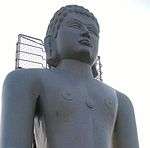Shrivatsa
The Shrivatsa (Sanskrit śrīvatsa) is an ancient symbol, considered auspicious in India.[1]
Srivatsa means "beloved of Sri", the goddess Lakshmi.[2] It is a mark on the chest of Vishnu where his consort Sri Lakshmi resides. It is said that the tenth avatar of Vishnu, Kalki, will bear the Shrivatsa mark on his chest.It is one of the names of Vishnu in the Vishnu Sahasranamam.Srivatsa is a popular name in Andhra Pradesh,Telangana and Tamil Nadu.

In Buddhism, the Srivatsa is said to be a feature of the tutelary deity (Tibetan: yidam) Manjusri the Youth (Skt: Manjusrikumarabhuta).[3] Tibetan Buddhists depict the shrivatsa as a triangular swirl or an endless knot.[2]
In Jain iconography

In Jainism, it often marks the chest of the Tirthankara image.[4] It is one of the ashtamangala (auspicious symbol). It can look somewhat like a fleur-de-lis, an endless knot, a flower or diamond-shaped symbol.[5]

Other uses

The shrivatsa is the symbol of Rakhine State and the Rakhine people of Burma.
Notes
- ↑ Sarat Chandra Das (1902). Tibetan-English Dictionary with Sanskrit Synonyms. Calcutta, India: Bengal Secretariat Book Depot, p. 69
- 1 2 The Handbook of Tibetan Buddhist Symbols, p. PA11, at Google Books
- ↑ Alex Wayman, "Chanting the Names of Manjusri" 1985, p. 94
- ↑ Red sandstone figure of a tirthankara
- ↑ Jain & Fischer 1978, p. 15, 31.
References
- Jain, Jyotindra; Fischer, Eberhard (1978), Jaina Iconography, Part 12- Iconography of religions: Indian religions, BRILL, ISBN 978-9004052598
Further reading
- Sutton, Nicholas (2000). Religious doctrines in the Mahābhārata. Motilal Banarsidass Publ. p. 153. ISBN 9788120817005.
| ||||||||||||||||||||||||||||||||||||||||||||||||||||||||||||||||||||||
| ||||||||||||||||||||||||||||||||||||||||||||||||||||||||||||||||||||||||||||||||||||||